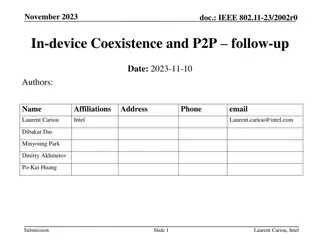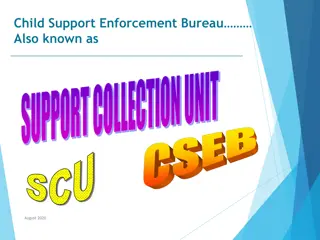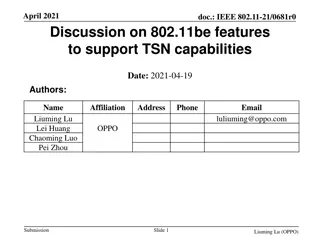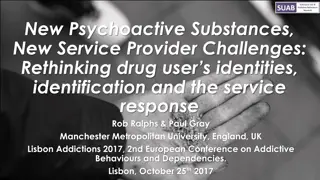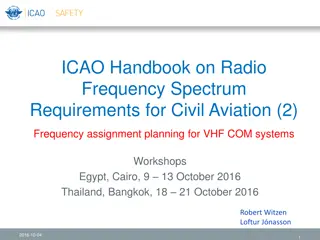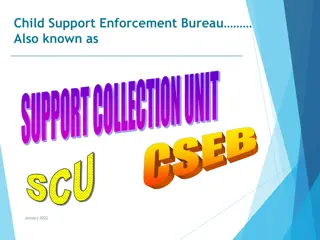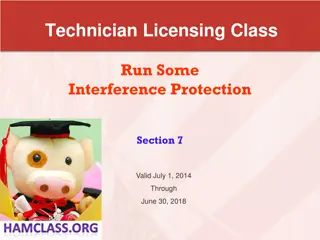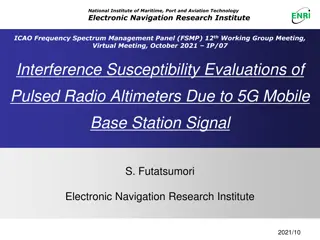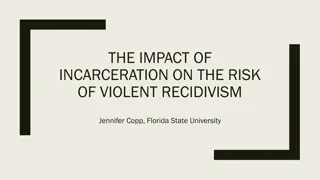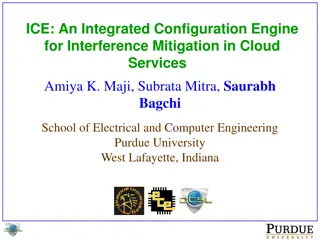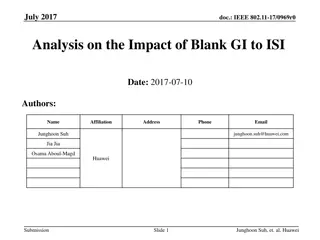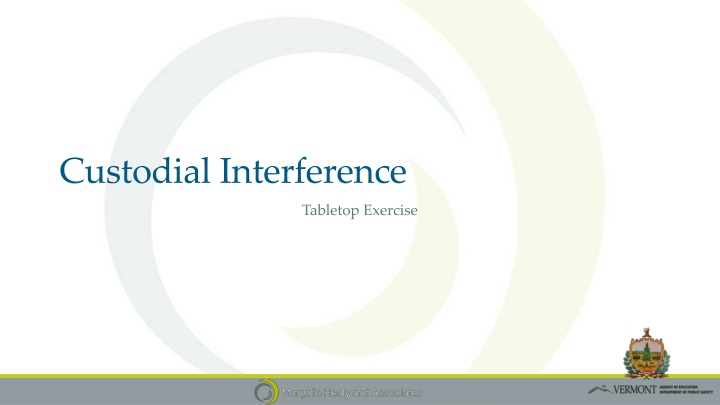
Effective Custodial Interference Tabletop Exercise for School Preparedness
Enhance school preparedness through a comprehensive tabletop exercise focused on custodial interference situations. Assess awareness, response coordination, and community engagement to develop corrective action plans and strengthen relationships with response partners.
Download Presentation

Please find below an Image/Link to download the presentation.
The content on the website is provided AS IS for your information and personal use only. It may not be sold, licensed, or shared on other websites without obtaining consent from the author. If you encounter any issues during the download, it is possible that the publisher has removed the file from their server.
You are allowed to download the files provided on this website for personal or commercial use, subject to the condition that they are used lawfully. All files are the property of their respective owners.
The content on the website is provided AS IS for your information and personal use only. It may not be sold, licensed, or shared on other websites without obtaining consent from the author.
E N D
Presentation Transcript
Custodial Interference Tabletop Exercise
Exercise Agenda Welcome and Introductions Housekeeping Exercise Overview Goals Rules Objectives/Core Capabilities Assumptions and Artificialities Roles and Responsibilities Schedule Structure Scenario-Driven Exercise Facilitated Discussion in Four Modules Hot Wash Closing Comments Debrief
Welcome and Introductions Opening Remarks Facilitator Introductions Hosting Agency Participants Exercise Staff
Exercise Goals Test plans to prepare for, respond to, and recover from a custodial interference situation in our school. Ensure effective coordination of plans and actions with school and community partners. Strengthen relationships with our response partners. Identify areas for improvement and develop a corrective action plan.
Objectives and Core Capabilities Assess the awareness of school administration surrounding The Family Education Rights Privacy Act (FERPA) and the existing plans to prepare for, mitigate, respond to, and recover from parental custodial disputes. Assess the ability to effectively deliver relevant and appropriate information to school officials regarding the hazard, the status of actions taken by the school, and the effective steps taken to ensure the safety of the child. Assess the ability to effectively establish and maintain a coordinated operational structure that integrates critical recovery actions.
Objectives and Core Capabilities (cont.) Assess the ability to effectively integrate whole school community services and resources into emergency response and recovery efforts. Assess the ability to effectively engage whole school community partners in meeting their needs and to effectively provide all decision makers with timely notifications.
Participants Roles and Responsibilities Players: Respond to the situation presented, based on expert knowledge of response procedures, current plans and procedures, and insights derived from training. Facilitator(s): Responsible for moderating and keeping participant discussions focused on exercise objectives and core capabilities, and ensuring relevant issues are explored; provide situational updates and additional information; resolve questions as required.
Exercise Structure A scenario-driven, facilitated discussion-based exercise The exercise is divided in four modules: oModule 1: Initial Response Scenario Background oModule 2: Response Scenario Update #1 oModule 3: Response Scenario Update #2 oModule 4: Recovery Scenario Update #3 Debrief
Rules for Players There are no right or wrong answers/ideas. Varying viewpoints are expected and will be respected. Exercise decisions are not precedent setting. Players are encouraged to consider different approaches and suggest improvements/ Think outside the box.
Ground Rules This is not a test of current capabilities and plans. It is a discussion of probable responses to a hypothetical emergency. The exercise will be an open dialogue. All ideas and input are welcome. One person speaks at a time. The scenario will be accepted as is. However, the facilitator may make modifications as deemed appropriate. No hypothetical resources are available.
Assumptions and Artificialities The exercise is conducted in a no-fault learning environment wherein capabilities, plans, systems and processes will be evaluated. Participants respond to the TTX scenario events and other exercise information from the perspective of their school s current policies, plans, processes and capabilities. The exercise scenario is plausible, and events occur as they are presented in the TTX scenario, allowing for artificialities. All players receive information at the same time.
Exercise Schedule Exercise Logistics and Set-up Registration Welcome and Introductions Exercise Overview Module 1: Initial Response Scenario Background Break Module 2: Response Module 3: Response- Update 1 Module 4: Recovery Break Hot Wash Closing Comments Debrief
Tabletop Processes A scenario and update statements will be used to generate discussion of probable response actions. Participants will provide situational responses based on established procedures and plans. The Emergency Operations Plan (should be) available for reference. Other than maps and diagrams, no additional materials will be provided. The exercise will conclude with development of action steps needed to support future mitigation and preparedness efforts.
Exercise Guidelines Respond based on your knowledge of your school plans and capabilities. Discuss and present multiple options and possible solutions. Be aware that each phase will not have complete resolution. Any issues that cannot be resolved within a reasonable period of time will be tabled as an after-action item. If more information is needed, ask. Assume any agencies that are requested are initiating their response plans.
Module 1 Initial Response: Scenario Background
Date: Time: It s the Wednesday before Thanksgiving break and it is also an early release day. A non-custodial parent, who s known by the school to have a restraining order against her, enters the building and quickly leaves, taking her child from the classroom. Moments later a crossing guard calls the main office and reports that there is a physical altercation involving two parents outside of the school.
Scenario The situation is witnessed by many and is immediately reported to the main office by the classroom teacher. The main office immediately calls 9-1-1 . A loud physical altercation is occurring outside; as the custodial parent (Father) is trying to pull the child from the non-custodial parent s (Mother s) vehicle. The family has been involved in a longstanding custody dispute and their two smaller children are also in the vehicle.
Discussion What notifications must be made internally and externally? Based on the information that you have, what specific response actions do you choose to take? Why? Based on the response action chosen what are your concerns?
Module 2: Response
Date: Time: The police respond to the school and a small crowd has gathered in the parking lot. Many students are watching from the windows. The non-custodial parent (mother) is placed under arrest. The children involved are scared and emotional having witnessed the situation.
Discussion What services do you have in place to assist the children in this situation? Does the school have a visitor management process? If so, what failed? Does this information change your ongoing planning? If so, how? What types of messaging now must be made to the school community? Who is responsible for this messaging? (Take 5 minutes to develop this message that will be communicated to the school community)
Module 3: Response - Scenario Update
Date: Time: The police have transported the non-custodial parent and the Department of Children and Families (DCF) has been called. The custodial parent (father) is threatening to sue the school. He is demanding answers as to how this situation could have occurred.
Discussion The restraining order was previously provided to the school, based on that, what information will you provide to the police? How will you work with the children and father following this incident? What other immediate concerns need to be addressed? What demands can and cannot be met regarding the non- custodial parents rights going forward? How do we strengthen our security policies and practices to ensure this does not occur again?
Module 4: Recovery
The children returned home with the custodial parent. The following day the child was connected with internal counseling services and assigned a case manager from DCF. The custodial parent has made an appointment with the superintendent to discuss his grievances with the school.
Many students witnessed the situation from classroom windows and were traumatized by the events. The student at the focus of this event is now experiencing bullying from other students in the school. The school is receiving telephone calls from concerned parents due to the situation posing a threat to their children. A parent group has called for an emergency open forum meeting for the community to discuss the school s demonstrated vulnerabilities.
How will you handle the scheduled community event? What can you do to address parents concerns? What insights has participating in this exercise provided you about your school s or district s state of readiness for this kind of incident? What revisions would you recommend to your emergency operations plan (EOP)? What is the current procedure for notifying parents of these types of events should they occur? How do you handle internal and external communications, and is this written in your plan?
Hotwash Did this exercise increase your awareness of school mitigation and preparedness needs? How? Will this exercise provide input for continued emergency operations planning? How? What action steps should this group take now? What are the major lessons learned from today s discussion? What are tentative next steps to continue the discussion and address any areas of concern?
Where do we go from here? Specific Issues Identified Person assigned to follow-up Timeline of completion 3, 6, 9 months
Contact the Vermont School Safety Center Web Site Vermont School Safety Center Web Site Twitter https://twitter.com/vted_safeschool
Stay Connected With Us @margolishealy www.facebook.com/margolishealy www.linkedin.com/company/margolis-healy-&-associates


